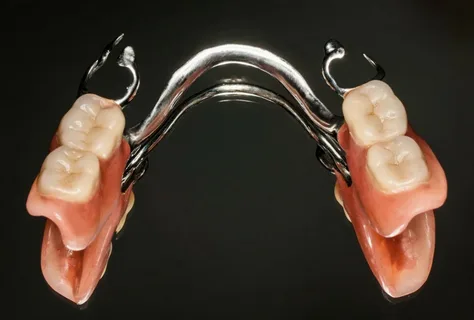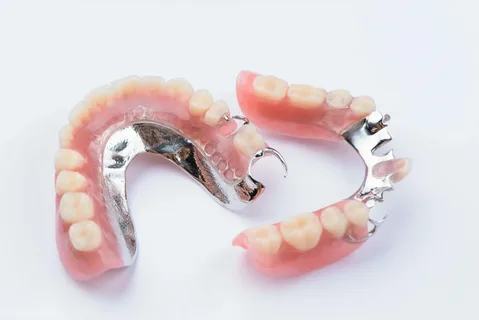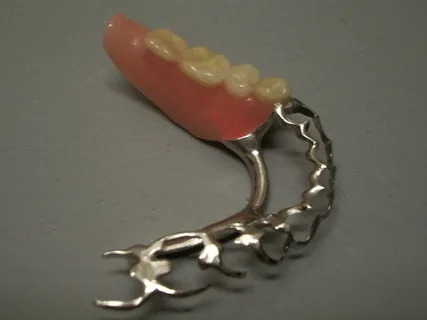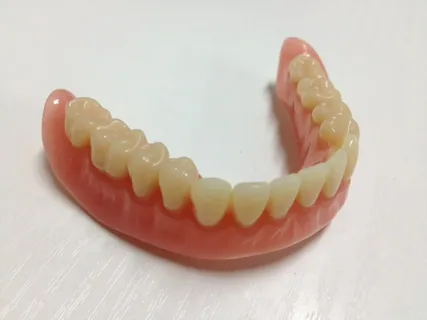Comparative Characteristics of Partial Removable Dentures
Machine translation
Original article is written in RU language (link to read it) .
Caries and its complications, malocclusions, non-caries tooth lesions, periodontal diseases, traumatic injuries, odontogenic and non-odontogenic inflammatory diseases of the jaws, and neoplasms lead to the formation of defects in the dental arches in patients. In 70% of patients older than 45 years, the integrity of the dental arches is compromised.
Learn all about removable prosthodontics for the "orthopedist - dental technician" team in the online course Complete Removable Prosthodontics.
Dental arch defects represent an irreversible process, a severe disease of the dentomaxillary system, which is accompanied by the development of other pathological conditions with characteristic symptoms.
Without specialized dental care, the patient cannot manage. Orthopedic treatment allows to eliminate the acquired defect of the dental arch, halt or completely relieve the patient from destructive and inflammatory processes, and prevent further deformations. The basis of prosthodontics is the ability to transfer some of the load to the periodontium of the supporting teeth due to their physiological reserves, but with mandatory consideration of the endurance limit of these teeth.

Figure 1. Partial removable denture plate.
Types of Dentures
All dentures used to address defects in dental arches are divided into the following groups:
- Bridge dentures. The feature of these structures is that they primarily rely on the teeth that border the acquired defect. The load is transferred through the periodontium of the supporting teeth. Thus, these dentures are considered physiological.
- Partial removable dentures. These are removable dentures, among which there are both supported and unsupported types. The load in supported constructions is perceived and transmitted in a mixed manner: through the periodontium of the teeth on which the denture is fixed, and also through the alveolar ridge. The latter is covered with tissues that are absolutely not adapted to perceive this load. The group of supported dentures includes arch and bar constructions (Bugel in German means arch) and removable plate dentures, which have elements in their design that provide mixed-method pressure transmission.
- To the unsupported dentures belong plate dentures equipped with retaining clasps, which exclusively transmit chewing pressure to the palate, jaw body, and alveolar processes – tissues forming the prosthetic bed, absolutely not adapted to withstand the load.
Bridge prostheses are the earliest constructions that were used to restore the integrity of the dental arch; they are the most common prostheses and can almost completely restore the chewing efficiency of a patient.

Figure 2. Bridge prosthesis.
In addition to bridge prostheses, removable prostheses are used for more extensive defects of the dental arch. As the extent of the defect increases, the indications for creating a non-removable structure decrease, while those for a removable one increase.
Design Features of a Removable Modern Denture
The design features of a removable denture depend on a number of factors:
- the topology of the defect;
- the extent of the defect;
- the number of remaining teeth;
- the condition of the remaining teeth in the oral cavity, their periodontium;
- the condition of the mucous membrane lining the denture bed;
- the degree of atrophy of the alveolar ridge;
- anatomical features of the hard palate.

Figure 3. Metal base.
Regardless of the design features, any removable denture includes:
- base,
- clasps, retaining devices,
- artificial teeth.
In addition to the listed elements, the arch denture is also equipped with an arch and its branches.
The main disadvantage of plate dentures is their placement on tissues that are not capable of perceiving masticatory pressure, which for this reason does not reach the necessary magnitude, as with bridge dentures, where the masticatory pressure is transmitted through the periodontal teeth in a natural way.
This accounts for the fact that the chewing efficiency or functional value of unsupported removable plate dentures is significantly lower than that of bridge dentures. The main reason for this difference lies in the perception of pressure by tissue that is not suitable for these purposes.
The action of constant pressure from the base on the specialized tissues of the denture bed, which are incapable of perceiving it, triggers the onset of atrophic phenomena. There is an increase in the desquamation of the epithelium, which leads to a weakening of the mucosa's resistance to various irritants, consequently initiating an inflammatory process with a chronic course. The part of the denture that adjoins the edge of the gum and the necks of the teeth provokes the development of cervical caries, periodontal disease with the progressive formation of pathological periodontal pockets. The clasps that fix the denture constantly slide over the surface of the crown of the supporting tooth. As a result, the denture either sinks into the mucosa under load or returns to its original position when the load is removed. Such sliding causes trauma to the enamel, accompanied by the appearance of hyperesthesia, and subsequently – carious lesions.
The undeniable advantage of removable dentures compared to fixed bridges is their hygiene.

Figure 4. Clasp denture.
Considering the disadvantages of the described types of dentures, their evolution moved towards preserving removability, minimizing the extent of the denture base, evenly redistributing the chewing pressure between the supporting teeth and the mucosal bed of the denture while simultaneously increasing the functional value and stability of the denture. Reducing the extent of the base increases the specific pressure. To compensate for this phenomenon, part of the load was redistributed to the supporting teeth. This trend led to the emergence of supported dentures.
Elements of a Removable Denture
Despite gradual modernization, the fundamental structural elements of a plate removable denture remain:
- base (made of metal or plastic),
- artificial teeth,
- fixing mechanical devices.
Base
A plate made of metal or plastic is the foundation, or base, of any removable denture, on which artificial teeth are fixed, as well as elements that ensure the retention of the denture in the mouth. The base is located on the lower jaw – on the alveolar ridge, and on the upper jaw – also on the hard palate. Artificial teeth transmit chewing pressure through the base to the mucosal bed of the denture.
Negative phenomena associated with the denture base:
- disruption of all types of sensitivity in the area of the mucosal bed of the denture,
- speech impairment,
- complicated self-cleaning of the mucosa,
- frequent development of a gag reflex,
- mucosa is prone to inflammatory changes,
- pathological periodontal pockets often occur in the area of the supporting teeth.
Requirements for the Denture Base
It must be elastic, sufficiently strong, and have minimal plasticity to redistribute chewing pressure evenly on the tissues of the denture bed.
To maintain a good level of hygiene, the base material should minimally adsorb food products, elements of oral fluid, and be easily subjected to regular hygienic cleaning.
Denture base plastics have become widely used as a material for denture bases, primarily consisting of acrylic polymers, as well as copolymers and fillers.
It is impossible to manufacture a high-strength base from base plastic; for these purposes, metal alloys are used: cobalt-chrome alloy, stainless steel.
Precious metals and their alloys are not used for making bases due to their insufficient strength, costliness, but the main reason is that the finished removable denture becomes too heavy, which is unacceptable for treating patients, especially with defects in the upper dental rows.

Figure 5. Full removable denture.
The thickness of the metal base is significantly less than that of the plastic one, and its strength is better. Due to good thermal conductivity and thin base, patients adapt to metal bases faster and better, but it is very important that the internal relief of the denture closely follows the micro-relief of the denture bed. This can be achieved by precision casting of cobalt-chrome alloy.
The extent of the denture base is determined by the number of remaining teeth in the patient, the degree of bone tissue atrophy, the presence of a torus, and the prominence of the palatal arch, as well as the compliance of the mucosa.
Detailed digital and analog protocols for making removable dentures at clinical and laboratory stages in the online course Complete Removable Prosthodontics for Doctors and Technicians.
